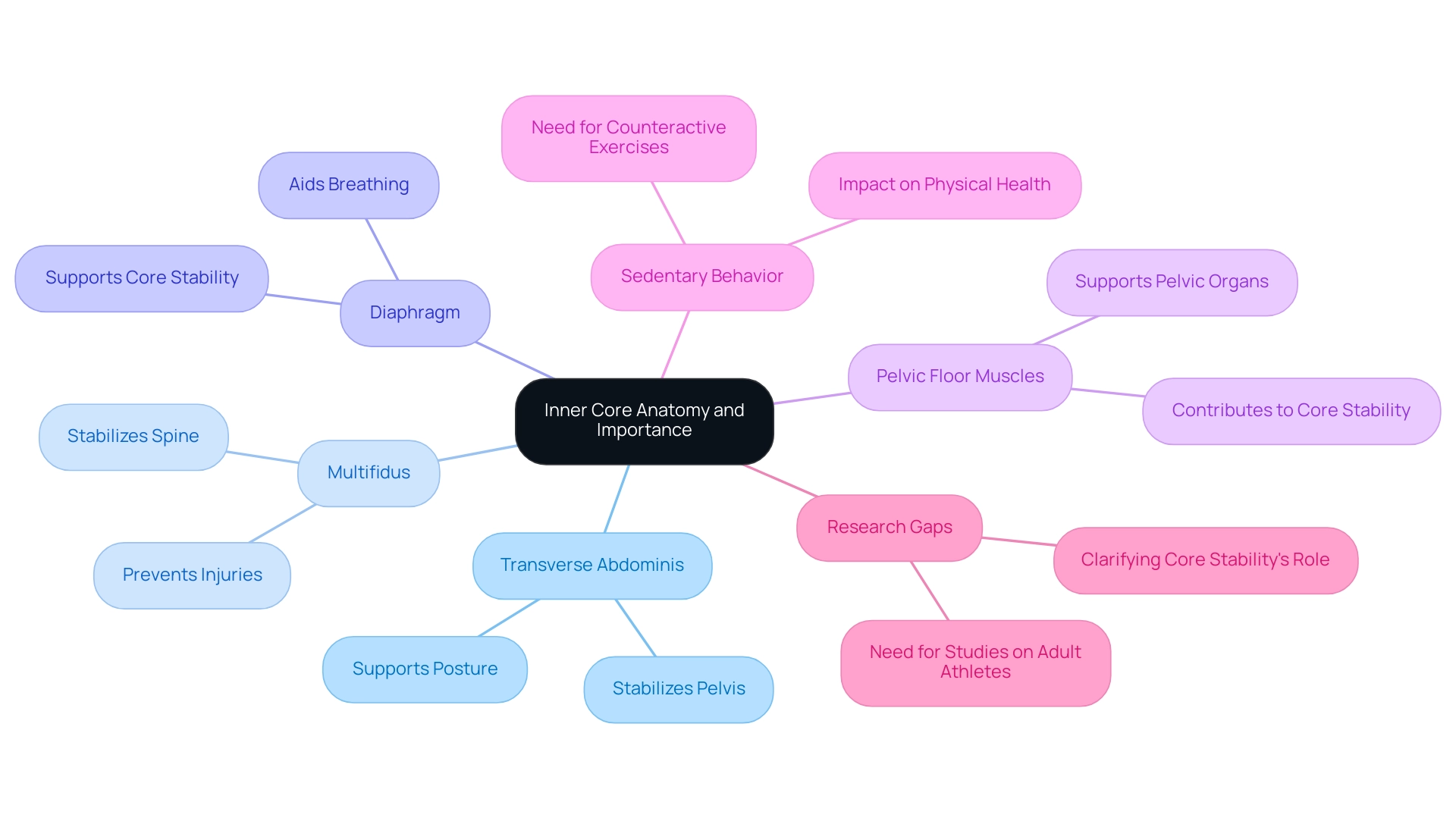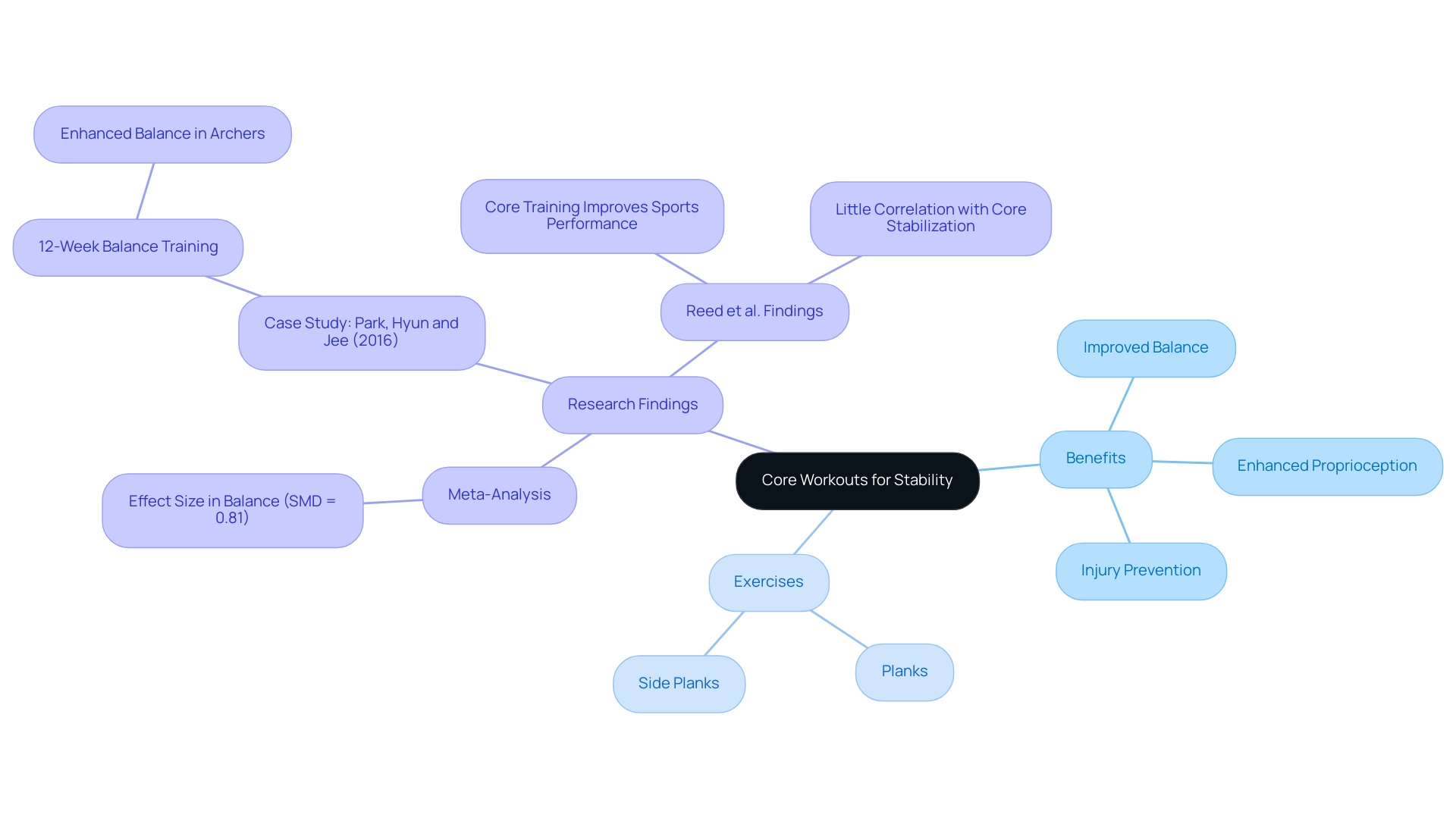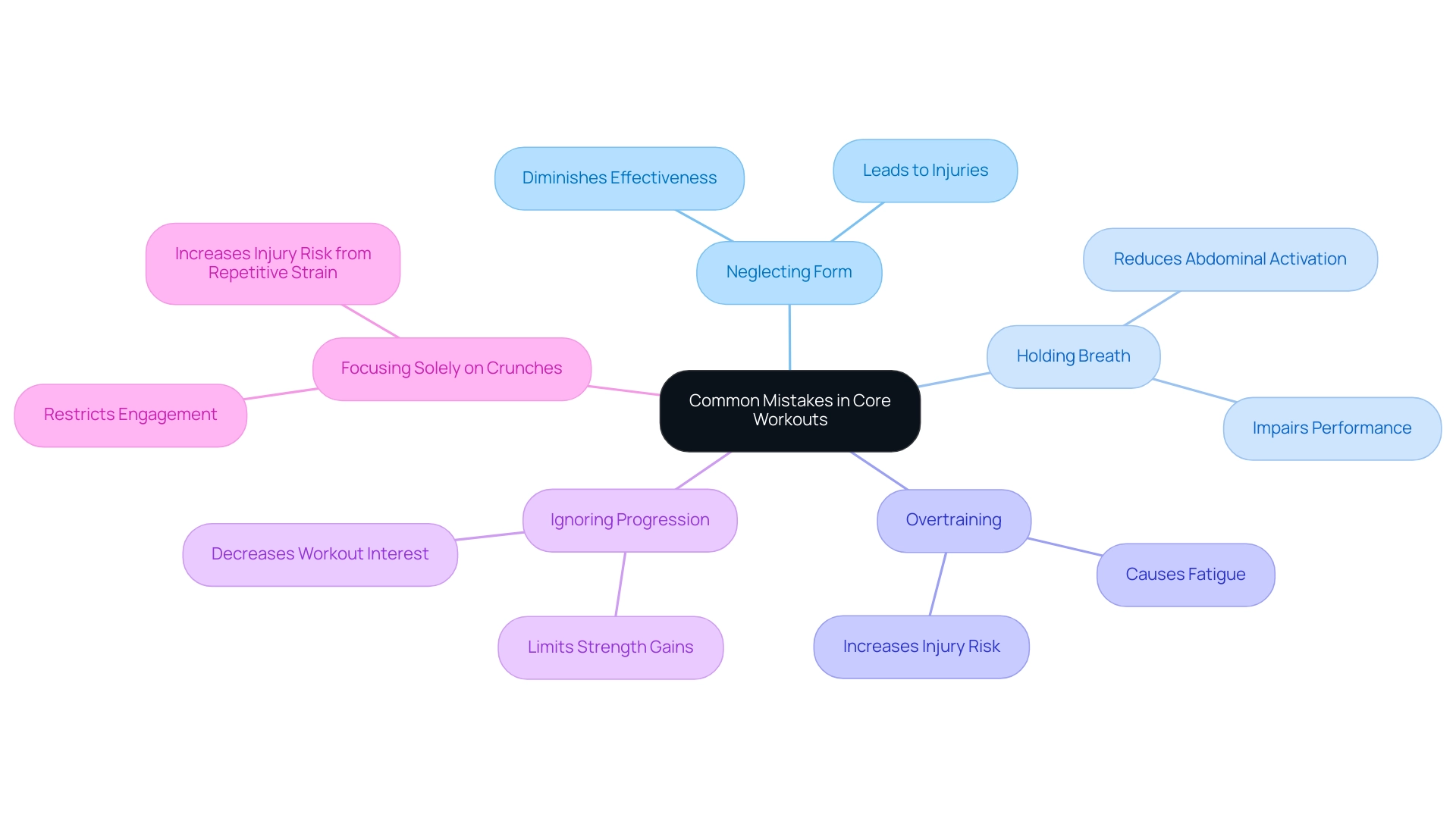Overview
To perform inner core workouts effectively, it is essential to focus on exercises like planks, dead bugs, bird dogs, bridges, and side planks, which target the inner core muscles crucial for stability and posture. The article emphasizes that incorporating these exercises into a regular fitness routine not only enhances overall physical performance and injury prevention but also supports daily activities, underscoring their importance for both athletes and the general population.
Introduction
The inner core is the unsung hero of physical fitness, often overlooked yet crucial for both athletes and everyday individuals alike. Comprising essential muscles such as the transverse abdominis and diaphragm, it plays a vital role in stabilizing the pelvis and spine, which are fundamental for maintaining proper posture and preventing injuries.
As modern lifestyles become increasingly sedentary, the urgency to counteract this trend with targeted core workouts has never been more critical. By understanding the anatomy and functionality of the inner core, one can appreciate the profound impact that strengthening these muscles can have on overall health and athletic performance.
This article delves into:
- Effective core strengthening exercises
- The importance of stability and balance
- The role of breathing techniques in maximizing core activation
It also highlights common mistakes to avoid, ensuring that individuals can embark on their fitness journey with confidence and purpose.
Understanding the Inner Core: Anatomy and Importance
The inner layer is composed of several essential muscles, including the transverse abdominis, multifidus, diaphragm, and pelvic floor muscles. These muscles play a pivotal role in stabilizing the pelvis and spine, which is crucial for maintaining proper posture and preventing injuries. A strong inner structure not only enhances athletic performance but also supports essential daily activities such as lifting, bending, and twisting.
Recent insights from Fatma Çelik Kayapinar emphasize that the results of our study suggest that training programs contribute to the posture improvement in volleyball players positively. This emphasizes the profound impact of focused exercises on athletic outcomes. Furthermore, with 77.5% of Group 2 participants utilizing their mobile devices to spend leisure time online, it's crucial to acknowledge how sedentary behaviors can impact physical health and the significance of countering this with effective exercises.
Additionally, a review titled 'Gaps in Research on Postural and Core Stability' underscores significant gaps in the literature regarding the relationship between postural/core stability and sport-specific performance, indicating a pressing need for further studies on adult athletes. By deepening your understanding of the anatomy and functionality of the inner structure, you can truly appreciate the necessity of incorporating focused workouts into your fitness regimen. Strengthening these muscles can lead to significant benefits not just for athletes but for everyone looking to bolster their physical health and well-being.

Step-by-Step Guide to Effective Core Strengthening Exercises
-
Plank: Begin by positioning yourself in a push-up stance, ensuring your body forms a straight line from head to heels. Aim to hold this position for 30 seconds, gradually increasing your duration as you build strength. This fundamental activity is vital for enhancing inner core workouts, which are important for central stability, strength, overall fitness, and well-being. At Foresight Health Coaching, we recognize that a solid foundation promotes overall well-being, which is why our customized fitness programs include activities like this to improve physical performance across different pursuits.
-
Dead Bug: Lying on your back with your arms extended toward the ceiling, lower one arm and the opposite leg toward the floor while keeping your back pressed firmly against the ground. Return to the starting position and repeat with the opposite limbs. This activity enhances coordination and engages the inner core workouts, which are vital for functional movement and daily tasks. Our customized coaching services guarantee that clients obtain direction on these activities suited to their particular requirements.
-
Bird Dog: Position yourself on all fours, extending one arm forward while simultaneously extending the opposite leg back. Hold this position for a few seconds before switching sides. This activity not only enhances stability but also promotes better coordination, making it a favorite among trainers. Ioannis Tsartsapakis notes,
The bird dog and side plank activities, when combined with the hollowing maneuver, may be particularly advantageous.
At Foresight, we emphasize these practical movements as part of our holistic health approach.
-
Bridge: Lie on your back with your knees bent. Lift your hips toward the ceiling, squeezing your glutes at the peak of the movement. Hold for a moment before lowering back down. This activity targets the glutes and lower back while reinforcing inner core workouts, which contribute significantly to overall body stability. Integrating these fundamental activities into your wellness programs can effectively enhance employee health.
-
Side Plank: Lying on your side, support your body on one forearm and lift your hips off the ground, ensuring a straight line from head to heels. Hold for 30 seconds on each side. This variation of the plank is particularly effective for targeting the obliques and enhancing lateral stability. By integrating inner core workouts into your corporate wellness initiatives, you can foster a healthier, more resilient team.
To achieve optimal results, incorporate inner core workouts into your routine 2-3 times a week. A recent study of essential training effects discovered that organized abdominal exercises can result in substantial enhancement in abilities, with a significant effect size for training sessions extending beyond 30 minutes (ES = 2.68). Additionally, the research named 'Core Training Effects on Jumping Outcomes' evaluated the influence of central training on vertical and horizontal jumping outcomes, showing a moderate effect for vertical jumps (SMD 0.69) and a large effect for horizontal jumps (SMD 0.84). This evidence highlights the impact of dedicated fundamental workouts on enhancing physical performance, including vertical and horizontal jumps, as demonstrated in various studies. Furthermore, the implications for rehabilitation initiatives and fitness training centered on stability are significant, particularly for HR Benefits Managers interested in employee wellness programs. With a commitment to fundamental strengthening through our comprehensive coaching services, including nutritional guidance and wellness workshops, as well as the support of our app that enhances connectivity among clients, you can foster a healthier, more resilient team.

Enhancing Stability and Balance Through Core Workouts
A strong foundation is essential for attaining optimal balance and stability in all physical activities. Inner core workouts are vital for enhancing proprioception, which is the body's ability to perceive its position in space. This heightened awareness is crucial for preventing falls and injuries, especially in high-impact sports.
Exercises such as planks and side planks serve as excellent inner core workouts that not only fortify the core but also activate stabilizing muscles across the entire body. By incorporating inner core workouts into your fitness routine, you significantly improve your overall stability. This enhancement not only makes daily tasks more manageable but also improves abilities in sports and fitness pursuits.
Recent research highlights this significance, demonstrating a substantial effect size in balance enhancement among athletes engaged in foundational training (SMD = 0.81). Additionally, Reed et al. determined that skill in athletic activities such as a golf swing or running enhances with abdominal training, although they observed little connection between stabilization of the abdomen and results.
A relevant case study by Park, Hyun and Jee (2016) assessed archers and found that balance training over 12 weeks led to enhanced balance in the experimental group. Engaging in consistent inner core workouts can result in significant improvements in proprioception, directly influencing injury avoidance and athletic performance.

The Role of Breathing Techniques in Core Activation
Effective central activation begins with mastering the art of proper breathing techniques. As you begin your fundamental workouts, prioritize diaphragmatic breathing—inhale deeply through your nose, allowing your abdomen to rise fully, and exhale completely through your mouth. This coordination of breath with movement is crucial for fully engaging your abdominal muscles.
For instance, when executing a plank:
- Inhale as you set your body in position.
- Exhale while maintaining the hold.
This approach not only amplifies core engagement but also fosters relaxation, reducing tension throughout the body. As emphasized by Dr. Zubia Veqar, the inclusion of a diaphragmatic breathing pattern improves overall abdominal fitness and pulmonary functions, making your exercise routines not only more effective but also more enjoyable.
Furthermore, recent studies suggest that diaphragmatic breathing can significantly contribute to back pain prophylaxis, with a partial eta squared for the secondary outcome FABQ-W being 0.065, indicating a meaningful effect. By combining breathing techniques with activities like the Abdominal Draw-In Lumbar Stabilization, which has shown reduced low back pain and enhanced muscle function, you enable yourself to optimize your fitness routine with inner core workouts and cultivate a deeper connection with your body.

Common Mistakes to Avoid in Core Workouts
-
Neglecting Form: Prioritizing proper form is essential for any inner core workouts. A significant body of research highlights that poor technique can lead to injuries and diminish the effectiveness of your workouts. In fact, trainers emphasize that maintaining correct alignment not only enhances results but also protects against common injuries related to training. McGill & Marshall (2012) observed that participants aged 25.60 ± 3.40 years exhibited enhanced results with correct technique in fundamental workouts.
-
Holding Breath: It's common for individuals to forget about their breathing during abdominal exercises. Aligning your breath with movement is vital for enhancing abdominal activation. As Reed et al. concluded, "performance in sports movements like a golf swing or running improves with abdominal training," which relies on proper breathing techniques.
-
Overtraining: While consistency plays a vital role in building strength, excessive effort on your muscles can backfire, leading to fatigue and injuries. Experts recommend allowing adequate recovery time between sessions to let your muscles recuperate, ensuring sustained progress and preventing burnout.
-
Ignoring Progression: If an exercise feels too easy, it’s time to ramp up the challenge. Advancing to more challenging variations is essential for consistently enhancing fundamental strength. This method not only maintains workout interest but also ensures that inner core workouts are effectively targeting all regions of the midsection.
-
Focusing Solely on Crunches: Although crunches are a common choice, they primarily target a restricted area of the torso. To achieve comprehensive foundational engagement, it’s important to incorporate a variety of inner core workouts into your exercise routine. This diversity not only enhances strength but also reduces the risk of injuries linked to repetitive strain from over-focusing on one type of movement.
By avoiding these common pitfalls, you can enhance your fundamental exercises and attain impressive outcomes, paving the way for a stronger, healthier version of yourself. Additionally, the limitations of current meta-analysis highlight the need for more rigorous research designs in core training, emphasizing the importance of well-rounded and properly executed workouts.

Conclusion
Strengthening the inner core is not merely an exercise regimen; it is a fundamental investment in overall health and well-being. By understanding the anatomy of the inner core and its vital role in stabilizing the pelvis and spine, individuals can unlock a range of benefits that enhance athletic performance and daily functioning. Effective core workouts, including:
- Planks
- Dead bugs
- Bridges
should be incorporated into regular fitness routines to build a robust foundation that supports both physical activities and everyday movements.
Moreover, the significance of stability, balance, and proper breathing techniques cannot be overstated. These elements work synergistically to improve proprioception and reduce the risk of injuries, making them essential for anyone engaged in physical activity. Avoiding common mistakes such as neglecting form or overtraining will further optimize core workouts, ensuring that the journey toward a stronger core is both safe and effective.
Ultimately, prioritizing core strength is a proactive approach to health that benefits everyone, from athletes to those leading sedentary lifestyles. Encouraging a culture of fitness that emphasizes the importance of core training can lead to significant improvements in physical health, productivity, and overall quality of life. Taking action today to strengthen the inner core will pave the way for a healthier tomorrow.
Frequently Asked Questions
What muscles are included in the inner layer that contribute to stability?
The inner layer is composed of several essential muscles, including the transverse abdominis, multifidus, diaphragm, and pelvic floor muscles. These muscles play a crucial role in stabilizing the pelvis and spine.
Why is a strong inner structure important?
A strong inner structure enhances athletic performance and supports essential daily activities such as lifting, bending, and twisting, while also helping to maintain proper posture and prevent injuries.
How can training programs impact posture in athletes?
Recent insights suggest that training programs can positively contribute to posture improvement in athletes, particularly in volleyball players, highlighting the importance of focused exercises on athletic outcomes.
What is the significance of addressing sedentary behaviors?
With a significant percentage of individuals spending leisure time online, it's important to recognize how sedentary behaviors can negatively impact physical health, making effective exercises necessary to counter these effects.
What gaps exist in research regarding postural/core stability?
A review titled 'Gaps in Research on Postural and Core Stability' indicates significant gaps in the literature concerning the relationship between postural/core stability and sport-specific performance, emphasizing the need for further studies on adult athletes.
What are some core exercises that can strengthen the inner structure?
Key core exercises include: Plank (enhances inner core workouts and overall stability), Dead Bug (improves coordination and engages the inner core), Bird Dog (promotes stability and coordination), Bridge (targets glutes and lower back, reinforcing inner core strength), and Side Plank (effective for targeting obliques and enhancing lateral stability).
How often should inner core workouts be performed for optimal results?
It is recommended to incorporate inner core workouts into your routine 2-3 times a week for optimal results.
What evidence supports the effectiveness of core training?
Studies indicate that organized abdominal exercises can lead to significant improvements in physical abilities, particularly in vertical and horizontal jumping outcomes, with notable effect sizes for training sessions extending beyond 30 minutes.
How can these exercises benefit employee wellness programs?
Integrating inner core workouts into corporate wellness initiatives can foster a healthier, more resilient team, contributing to overall employee health and well-being.

